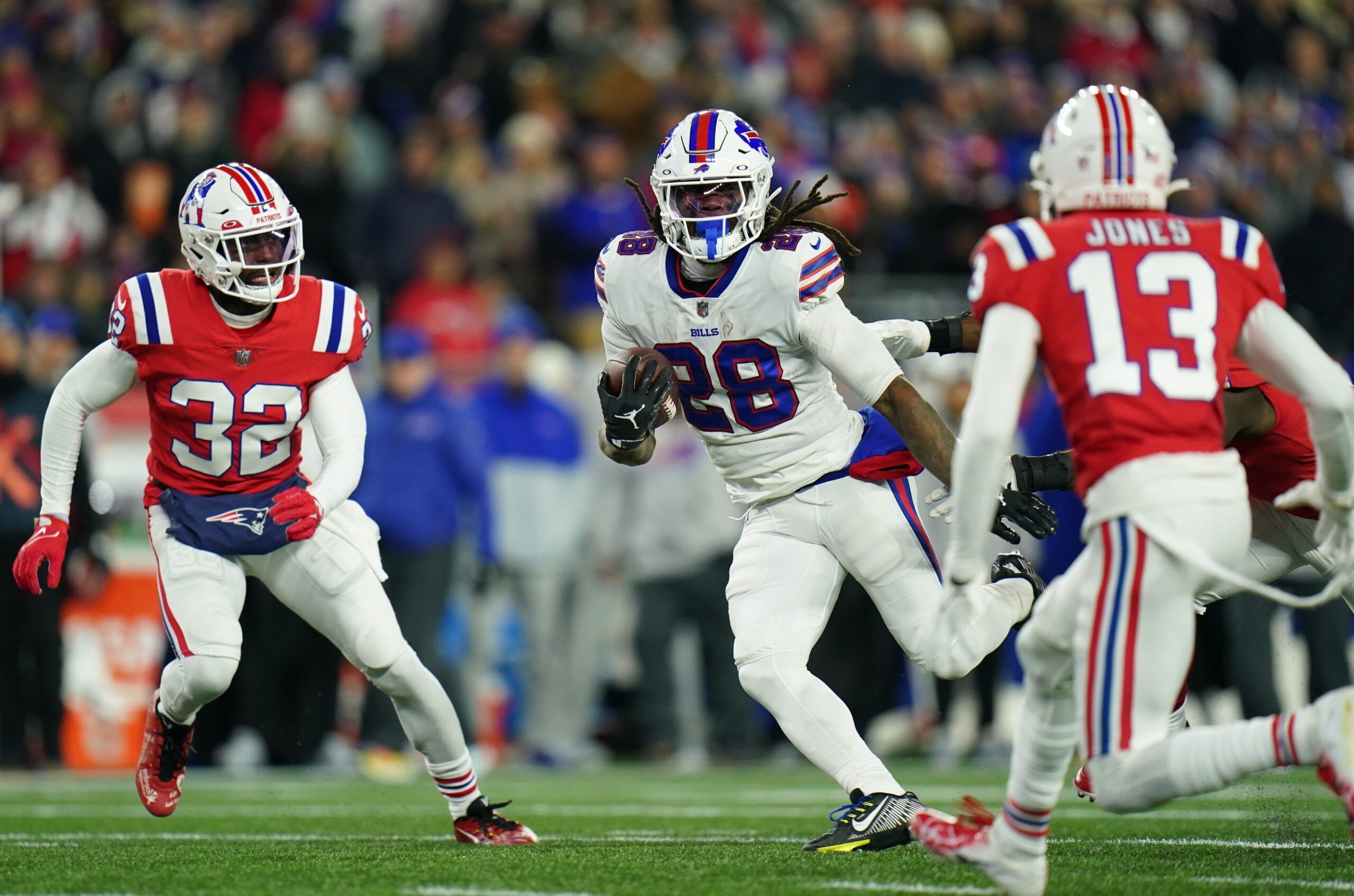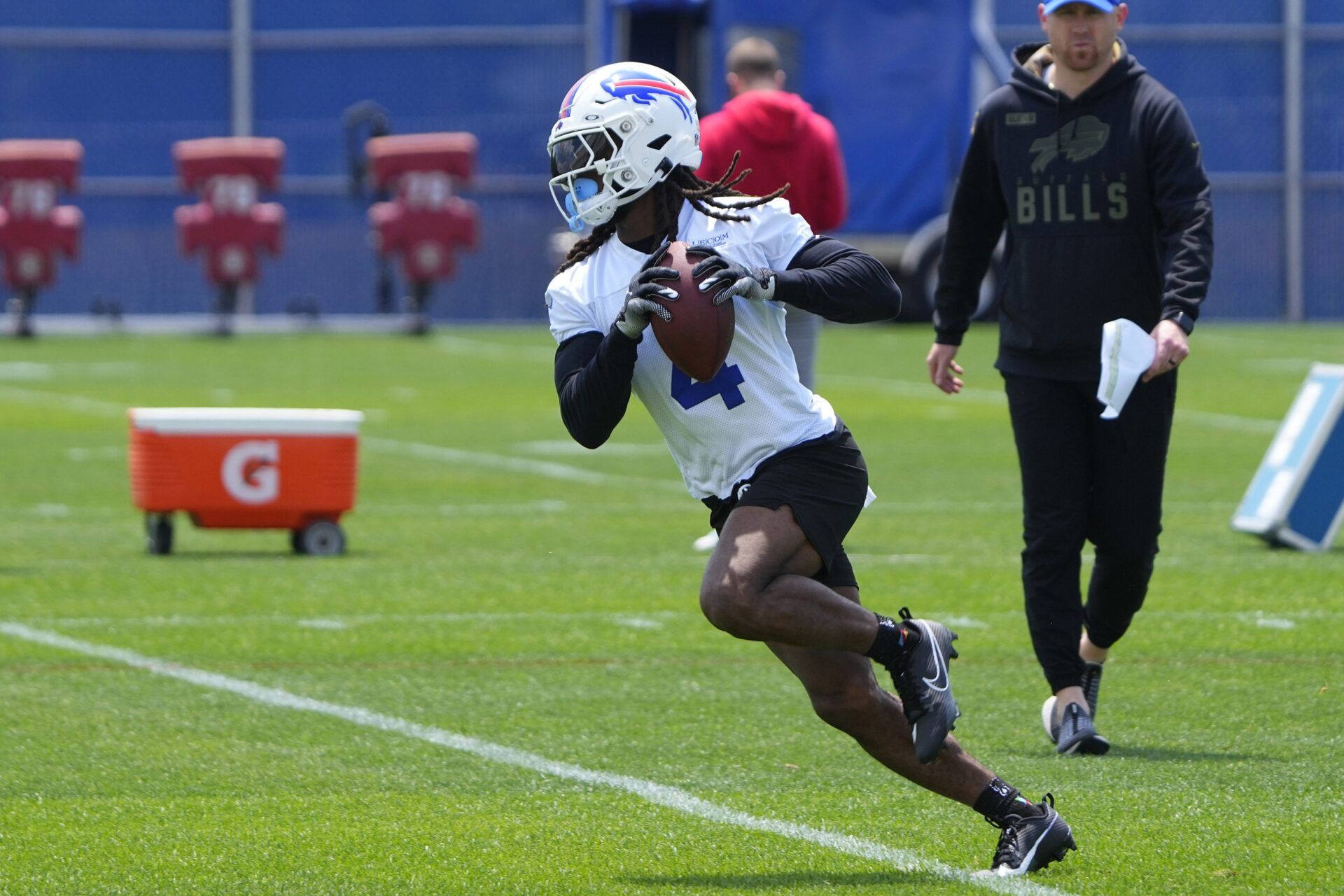Fantasy football managers love chasing the starting running back on elite offenses, even if those offenses don’t really run the football. For years, fantasy managers have been hoping to find a legitimate RB2 on the Buffalo Bills‘ top-tier offense. Could James Cook be the answer?
Does James Cook Have Top-24 Fantasy RB Upside?
In evaluating the Bills’ offense, the starting point needs to be 2020, which is when Josh Allen decided he was going to become really, really good at football.
Since then, we’ve seen Buffalo with only the combination of Devin Singletary and Zack Moss as their lead running back. Moss never even got remotely close to a top-24 finish. He’s a sub-replacement-level talent that the Bills rightfully gave up on last year.
Singletary, on the other hand, has a top-24 finish. He did so in 2021, averaging 11.6 PPR fantasy points per game and finishing as exactly the RB24. However, 11.6 ppg doesn’t typically crack the top 24. In 2019, Singletary’s best year, he averaged 12.3 ppg and finished as the RB28.
Last year, the RB24 averaged 11.7 ppg. That is on the low end of running backs to post RB2 finishes. Historically, we’re looking at 12.5-13.0 ppg as the last of the RB2s. And to be fair, if Cook finishes top 24 as a result of other running backs performing poorly, that’s not really in the spirit of what we’re trying to evaluate here.
So, for the purposes of this exercise, we’re going to say Cook needs to reach a conservative 12.5 points per game to have a shot at a top-24 finish. Now, how does he get there?
Last season, as a rookie, Cook averaged a paltry 6.3 ppg, finishing outside the top 48. He has a lot of progressing to do in order to reach top-24 status. The good news is the Bills shipped Moss off to Indianapolis in the middle of last season and let Singletary walk in free agency.
To replace them, Buffalo still has Nyheim Hines, who they acquired in the Moss deal but pretty much relegated to a pure special teamer last season. The Bills also signed Damien Harris and Latavius Murray in free agency to menial contracts. Unless they sign someone else, Cook is the clear lead back entering the 2023 season…for now.
The problem is Cook is not a three-down back, and I can confidently say he never will be. Cook is 199 pounds, and in college, his heaviest usage was 113 carries in 15 games — his final year at Georgia. That season, Cook did see a 7.9% target share, though. While not super high, he’s definitely a capable receiver.
We also saw Cook’s receiving acumen on display as a rookie. In Week 13, against the Patriots, Cook caught all six of his targets for 41 yards. As the season progressed, Cook started running more routes. From Weeks 1-12, he never ran more than nine routes in a single game. But from Week 13 forward, including two postseason games, Cook averaged 11.8 routes run per game. That number should increase even more now that he’s the lead back.

The challenge Cook will face is even if he sees upwards of a 10% target share (my projections only have him at 8%), he lacks the touchdown upside to have any sort of high ceiling. Touchdowns are everything in fantasy football. For every three receptions for 30 yards Cook amasses, Harris or Murray just need to fall in the end zone once to equal that.
Last season, the Bills targeted the RB position at a 20% rate. But that’s the outlier among the past three seasons. In 2021, Buffalo running backs collectively saw just a 15.4% target share, the fourth-fewest in the league. In 2020, that number was just 13.5%, also the fourth-fewest.
Cook’s path to the top 24 involves not only a higher target share but also goal-line work. Harris, Murray, and Allen will all have a higher priority at the goal line than Cook, who had just 16 red-zone touches last season and no goal-line touches.
My projections have Cook scoring just 3.4 touchdowns on the ground and 2.9 touchdowns through the air. In total, I have him averaging 9.9 ppg and finishing as the RB36. For Cook to find another 2.6 points per game, he would need to catch several more passes or score a lot more touchdowns.
How Likely Is James Cook To Finish as a Top-24 RB This Season?
Sadly, I don’t believe a top-24 finish is in Cook’s realistic range of outcomes. Of course, even when evaluating floor and ceiling outcomes for players, we’ll be wrong. Outlier seasons exist, and sometimes players just blow away our expectations in one direction or the other.
I have Cook projected for 187 opportunities (carries + targets). There’s certainly upside for me. It’s just I see the high end of his usage in the 220-230 range. Even if Cook sees that level of volume, based on the Bills’ 61% neutral-game-script pass rate, the infrequency with which Buffalo targets RBs, and the certainty that he won’t be the goal-line back, I just don’t see any plausible path to the top 24. Something extremely improbable would have to occur.
There’s also the chance the Bills sign a veteran like Dalvin Cook, Leonard Fournette, or Ezekiel Elliott. Signing any one of them would push James Cook’s already minuscule odds of a top-24 finish to below 1%.
Cook’s ADP is currently RB30. It’s rare that I think a player’s ADP is close to his ceiling and also fair, but that’s what we have with Cook. He’s very likely to finish inside the top 36, which would be a fine return on investment, even at an RB30 price. He’s just not going to be a guy that makes much of an impact.
There’s certainly use for players like that, but I prefer to shoot for more upside. As a result, I probably won’t be rostering much Cook in fantasy football this season.

